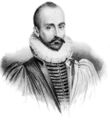Template:Selected anniversaries/September 13: Difference between revisions
No edit summary |
No edit summary |
||
| Line 12: | Line 12: | ||
File:Constantin Carathéodory.jpg|link=Constantin Carathéodory (nonfiction)|1873: Mathematician and author [[Constantin Carathéodory (nonfiction)|Constantin Carathéodory]] born. He will pioneer the axiomatic formulation of thermodynamics along a purely geometrical approach. | File:Constantin Carathéodory.jpg|link=Constantin Carathéodory (nonfiction)|1873: Mathematician and author [[Constantin Carathéodory (nonfiction)|Constantin Carathéodory]] born. He will pioneer the axiomatic formulation of thermodynamics along a purely geometrical approach. | ||
||1885 | ||1885: Wilhelm Blaschke born ... mathematician and academic. Pic. | ||
||1886 | ||1886: Robert Robinson born ... chemist and academic, Nobel Prize laureate. | ||
||Arthur Amos Noyes | ||1866: Arthur Amos Noyes born ... chemist, educator, and inventor. Along with Willis Rodney Whitney, he formulated the Noyes–Whitney equation, which relates the rate of dissolution of solids to the properties of the solid and the dissolution medium. Pic. | ||
||1887: Leopold Ružička born ... biochemist and academic, Nobel Prize laureate. | |||
1890: Aleksander Rajchman born ... mathematician who introduced Rajchman measures. Pic: http://mbc.cyfrowemazowsze.pl/dlibra/docmetadata?id=54559 | |||
File:Hannibal Goodwin.jpg|link=Hannibal Goodwin (nonfiction)|1898: Priest and inventor [[Hannibal Goodwin (nonfiction)|Hannibal Goodwin]] patents celluloid photographic film. | File:Hannibal Goodwin.jpg|link=Hannibal Goodwin (nonfiction)|1898: Priest and inventor [[Hannibal Goodwin (nonfiction)|Hannibal Goodwin]] patents celluloid photographic film. | ||
| Line 25: | Line 26: | ||
File:The Governess.jpg|link=The Governess|1900: Social activist and alleged superhero [[The Governess]] shames [[math criminals]] into returning stolen digits, paying compensation for lost computational power, and personally apologizing to everyone who was inconvenienced by this sorry episode of bad behavior, ''which will never be repeated.'' | File:The Governess.jpg|link=The Governess|1900: Social activist and alleged superhero [[The Governess]] shames [[math criminals]] into returning stolen digits, paying compensation for lost computational power, and personally apologizing to everyone who was inconvenienced by this sorry episode of bad behavior, ''which will never be repeated.'' | ||
||Herman Heine Goldstine | ||1913: Herman Heine Goldstine born ... mathematician and computer scientist, who was one of the original developers of ENIAC, the first of the modern electronic digital computers. Pic. | ||
||Herbert Reuben John Grosch (b. September 13, 1918) was an early computer scientist, perhaps best known for Grosch's law, which he formulated in 1950. Grosch's Law is an aphorism that states "economy is as the square root of the speed." | ||Herbert Reuben John Grosch (b. September 13, 1918) was an early computer scientist, perhaps best known for Grosch's law, which he formulated in 1950. Grosch's Law is an aphorism that states "economy is as the square root of the speed." | ||
Revision as of 19:31, 25 August 2018
1592: Philosopher and author Michel de Montaigne dies. He was one of the most significant philosophers of the French Renaissance, known for popularizing the essay as a literary genre.
1700: Mathematician, astronomer, and criminal investigator Giovanni Domenico Cassini publishes new study of the division of the rings of Saturn which reveals a series of previously unknown crimes against mathematical constants. This study will influence a generation of crime-fighting astronomers, leading to numerous breakthroughs in scientific law enforcement.
1873: Mathematician and author Constantin Carathéodory born. He will pioneer the axiomatic formulation of thermodynamics along a purely geometrical approach.
- 1890: Aleksander Rajchman born ... mathematician who introduced Rajchman measures. Pic: http://mbc.cyfrowemazowsze.pl/dlibra/docmetadata?id=54559
1898: Priest and inventor Hannibal Goodwin patents celluloid photographic film.
1900: Social activist and alleged superhero The Governess shames math criminals into returning stolen digits, paying compensation for lost computational power, and personally apologizing to everyone who was inconvenienced by this sorry episode of bad behavior, which will never be repeated.
2014: Army research laboratories convert modern plowshares into ancient swords. Military contractors call technique "Astonishing breakthrough."





